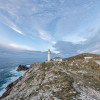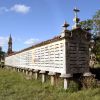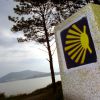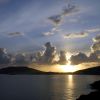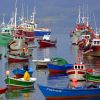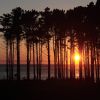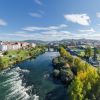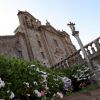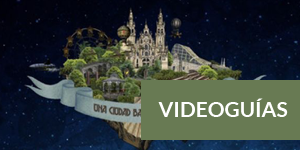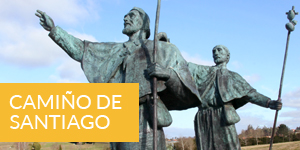- Accede I
- Regístrate I
- carrito
Costa da Morte - Fisterra
Duración: 1 día completo
Itinerario: Noia - Muros -Carnota - Corcubión - Finisterre
Descripción: El viaje a Fisterra, el fin de la tierra para los romanos, y a la recortada y peligrosa Costa da Morte es un rito ineludible para todos los que visitan Galicia. Tierra de leyendas ancestrales y de naufragios, posee una belleza melancólica y salvaje. Se bordea la ría de Muros y Noia desde su fondo, donde está la villa de Noia, para llegar al pintoresco y marinero Muros. Después, ya en pleno mar abierto, se divisan los extensos arenales de Carnota, donde está uno de los hórreos gigantes de Galicia. Por la falda del mítico Monte Pindo y por Ézaro, se continúa hacia la señorial Corcubión, de origen medieval. Al final, espera el cabo de Fisterra, considerado el extremo más occidental del continente, que marca el inicio de la Costa da Morte.
Paradas recomendadas
Noia-Muros-Carnota-O Pindo-Ézaro-Cee-Corcubión-Fisterra
El viaje a Fisterra y Costa da Morte es por su significación geográfica e histórica un rito ineludible para todos los que visitan Galicia, que sorprende además con verdaderos hallazgos paisajísticos y monumentales.
Desde Santiago el viaje se hace bordeando la ría de Muros y Noia desde su fondo, donde desemboca el río que la alimenta: el Tambre, uno de los más importantes de Galicia. Continúa por el pintoresco Muros y más allá, ya en pleno mar abierto, por los extensos arenales de Carnota, que posee uno de los hórreos más grandes de toda Galicia. Continúa el itinerario por la falda del mítico monte Pindo y por Ézaro -donde desemboca el Xallas, el único río de Europa que cae desde la altura directamente sobre el mar formando una cascada-, hasta llegar a la emocionante punta de Fisterra, nombre inseparable del de la Costa da Morte, considerada popularmente como el extremo más occidental del continente europeo desde que lo descubrieron los romanos en la expedición de Décimo Junio Bruto.
Las rocas graníticas condicionan la mayor parte de los paisajes de esta excursión, como se aprecia inequívocamente en el Monte Louro, que cierra la Ría de Muros y Noia en su parte septentrional y la protege de la fuerza del Atlántico. El Monte Louro es el icono paisajístico que guía la primera etapa de esta ruta.
En el paisaje destacan además la transparencia de las aguas, las largas playas de arena blanca finísima y las ensenadas salpicadas de villas marineras, algunas señoriales, como Noia -en el fondo de la ría-, Muros -en su margen septentrional- o Corcubión -llegando ya casi al Finisterre-. Son villas medievales construidas de granito, la piedra gallega por excelencia, la misma que asoma por todas partes en el paisaje. Son poblaciones de rúas estrechas y serpenteantes que confluyen en pequeñas plazas a las que se asoman acogedores soportales.
La Costa da Morte
El inicio de la Costa da Morte lo sitúan algunos en Muros. La denominación hace referencia al segmento noroeste del litoral gallego, a medio camino entre las Rías Altas y las Rías Baixas, que se extiende a lo largo de decenas de kilómetros, dentro de los límites de la provincia de A Coruña. Es una costa de playas desiertas, ensenadas y acantilados. Los cabos, entre los que despunta el de Fisterra, se adentran en un océano bravío y de aguas agitadas. Todo ello forma un paisaje inconfundible, sólo existente en este lugar.
La personalidad de la Costa da Morte está profundamente marcada por su condición de límite occidental de Europa. En realidad, el punto del continente situado más al oeste es el portugués Cabo da Roca, pero desde la Antigüedad el hombre ha considerado este lugar como el Finis Terrae, el fin del mundo, la puerta del Más Allá. A su llegada a este lugar, los romanos presenciaron y relataron el espectáculo del sol hundiéndose en el océano Atlántico, una escena grabada en la imaginación colectiva de los antiguos desde tiempos muy remotos. Fisterra es el final de muchos caminos. Hasta aquí se prolonga el viaje para cumplir los últimos ritos de la peregrinación jacobea llegando hasta el lugar donde se pone el sol, para volver a nacer, símbolo de la renovación de la vida.
Frente a estas costas navegó y navega buena parte del tráfico marítimo del Atlántico Norte. La costa abrupta, muy recortada, y las tormentas y temporales del invierno, explican que la Costa da Morte haya sido escenario de multitud de naufragios. Frente al mar es posible ver cruces que recuerdan a sus víctimas. De ahí su nombre.
Sus pueblos los habitan hombres y mujeres del mar. Una de las imágenes más representativas de esta zona es el trabajo de los 'percebeiros', saltando de roca en roca y esquivando los embates del mar. Como no podía ser de otra forma, la gastronomía de estos lugares saca partido de la gran calidad y variedad de sus pescados y mariscos.
En la Costa da Morte se mantiene todavía las tradiciones de sus antiguos oficios y labores de artesanía. El encaje de bolillos, sobre todo el de Camariñas, pero también el de otras localidades, ha merecido el reconocimiento internacional.
Es una tierra de misterio, de leyendas y de mitos. Su belleza paisajística e interés cultural la convierten en una zona única y de especial encanto.
Noia
Situada en el fondo de la ría de Muros y Noia, esta población fue importante en la historia de Galicia, y conserva todavía un interesante casco antiguo de origen medieval. En la villa hay dos templos que figuran entre los más importantes de la arquitectura gallega: Santa María A Nova (s. XIV), que contiene interesantes lápidas gremiales, y San Martiño (s.XV). Destaca también el de San Francisco y, en cuanto a espacios urbanos, la rúa de O Curro, con la Casa de la Escuela de Gramática.
Desde Noia hacia Muros la ría va abriéndose paulatinamente al mar. Una curva en la carretera, justo antes de entrar en la localidad de Esteiro, nos descubre de repente el monte que la cierra, uno de los más bonitos y de perfil más inconfundible de Galicia: el Monte Louro. A partir de aquí, playas de aguas transparentes y tranquilas y pequeños pueblos que cada vez se van separando más y anunciando la proximidad de la Costa da Morte.
Muros
Orientada hacia el sol del sur, y abrigado por las montañas de Carnota y de Mazaricos, el puerto medieval de Muros, Conjunto Histórico-Artístico y principal estación turística del Finisterrae, es la entrada simbólica que da paso a la Costa da Morte.
En el hermoso cuadro arquitectónico conservado en sus viejas calles de nombres sugerentes, destacan las construcciones religiosas sobre las civiles, lo que recuerda la pertenencia de Muros a la Mitra Compostelana. Entre ellas, la Iglesia de San Pedro (s.X), la antigua Colegiata de Santa María y actual Iglesia parroquial de San Pedro de Muros (s.XII), en la que predomina el estilo ojival sobre los restos románicos y conserva sepulcros de los s. XV y XVI.
Retomando la peregrinación a Finisterre, el camino recorre la parroquia de Louro, a escasos 3 km de Muros, donde se encuentra el Convento de San Francisco -del que sale un precioso vía crucis al aire libre que regala vistas sobre la ría-, y el ecosistema protegido del monte Louro, con su bella laguna de agua dulce al lado del mar y sus dunas.
Hórreo de Carnota
El largo hórreo de Carnota, Monumento Nacional, da celebridad a esta villa conservera, situada entre interminables playas y la majestuosa altitud del ancestral Monte Pindo. En el topónimo, de origen antiquísimo, la sílaba 'Carn', muy frecuente por toda Galicia, hace referencia a piedras o terrenos rocosos.
El hórreo de Carnota y su tradicional palomar, que forman parte del conjunto parroquial al que también pertenecen la iglesia de Santa Comba, el cementerio y la rectoral, son un típico ejemplo de la arquitectura rural gallega. Construido en sólida cantería, este hórreo es el segundo más grande de Galicia, con 34 m de largo y 11 pares de columnas o pies. Ocupa la primera plaza el hórreo de Araño -Rianxo-, el más largo del mundo, con 37 m de longitud.
El espacio ecológico de Carnota, que llega hasta la punta de Caldebarcos, junto al mágico monte Pindo, fascinante por su inusual tono rosado, acoge una variedad importante de especies migratorias y forma un conjunto único de dunas y marismas con una laguna interior. La gran playa está considerada como una de las más largas y hermosas de Galicia y también una de las 100 mejores del mundo, según la revista alemana 'Traum Strände' ('Playas de ensueño').
Corcubión
Encuadrada en el pintoresco marco paisajístico de las plácidas aguas de la ría de Corcubión, y casi unida con la vecina industrial Cee, esta población fue declarada Conjunto Histórico-Artístico en 1985.
En la Edad Media, además de la importancia de su flota, Corcubión contaba con un hospital para acoger a los peregrinos jacobeos que llegaban a la villa camino del Santo Cristo de Fisterra o del santuario de Nosa Señora da Barca, en Muxía, ruta obligada de todos aquellos que, después de rendir culto al Apóstol, terminaban su larga peregrinación en el Fin del Mundo.
Las fachadas vidriadas, el bonito paseo marítimo y sus viejas calles siguen atrayendo cada año a los visitantes que escogen esta villa como centro geográfico de sus vacaciones en el Finisterrae.
En la noble arquitectura de la villa destacan el pazo de los Condes de Altamira (s.XV), el puerto -reconstruido tras su destrucción por las tropas napoleónicas y por el bombardeo inglés para expulsar a los franceses-, la Casa Miñones, el Castillo del Cardenal -fortificación diseñada por La Ferrière en 1741 que en otra época defendía la ría con 12 piezas de artillería y 96 militares-, y las iglesias de San Marcos y de San Pedro (ambas del s. XII).
Fisterra
Fisterra posee todo el magnetismo de uno de los lugares míticos de la Antigüedad. Los pobladores de Europa veían en este punto el fin de la tierra conocida, la puerta del Más Allá. La imagen del sol poniéndose sobre las aguas del Atlántico aterraba y fascinaba a todo aquel que se asomaba a este extremo occidental del continente. Los rocosos acantilados de Fisterra, en lucha constante con las aguas del océano, han contribuido desde siempre a alimentar la leyenda de este lugar.
Fisterra, Finisterre, Finis Terrae, es un territorio marcado por el término, el ocaso, el límite, lugar al que hay que llegar para emprender el retorno.
En el núcleo urbano de esta villa con sabor marinero son de interés, entre otros, el puerto del pueblo y el Castillo de San Carlos. Donde comienza la subida hacia el mítico faro, está además el Santo Cristo de Fisterra, imagen que se encuentra en la Iglesia de Santa María das Areas (s. XII).
El faro de Fisterra ha sido rehabilitado por el arquitecto gallego de fama mundial César Portela, ganador del Premio Nacional de Arquitectura, que es también autor del insólito y arriesgado cementerio que se puede ver en la subida hacia el faro, motivo en sí mismo de múltiples visitas.
Sin embargo, aquí es sin duda el paisaje el verdadero protagonista: la línea de costa con sus acantilados, las playas agrestes y el propio océano. Y el cabo de Fisterra, en la vanguardia del océano, que mira a una infinita lejanía que se pierde en el mar.
Y no hay que olvidar las excelencias de la gastronomía, basada en los mejores productos del mar, entre los que destaca el 'longueirón', marisco emblemático de la zona.
En el 'fin de la tierra' finaliza esta ruta, que vuelve a Santiago por el interior -Negreira, Bertamiráns-, por un paisaje verde, ondulado, que contrasta con la inmensidad del mar que acabamos de dejar atrás.













